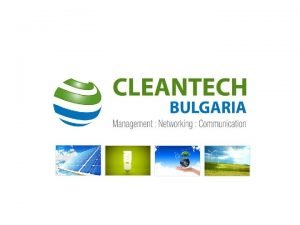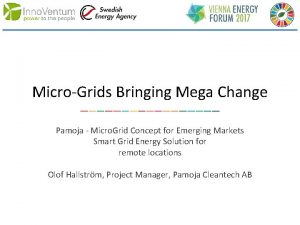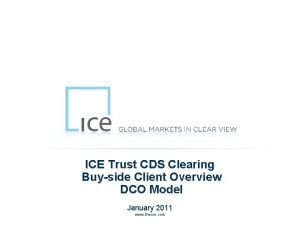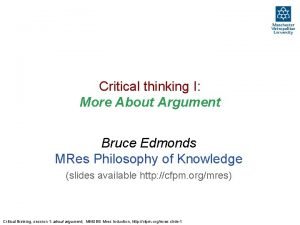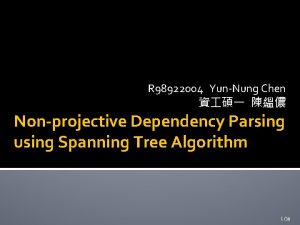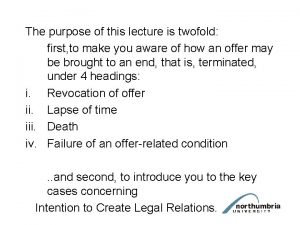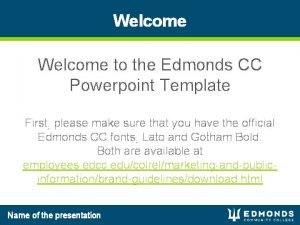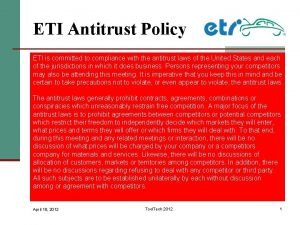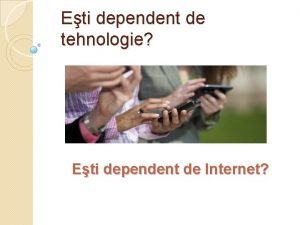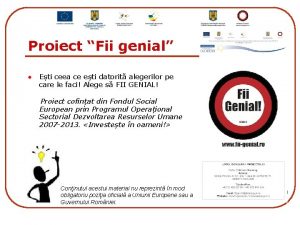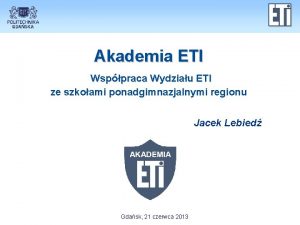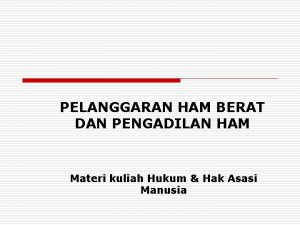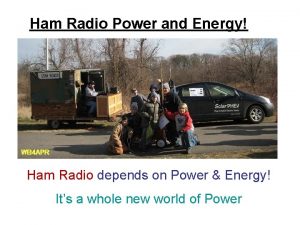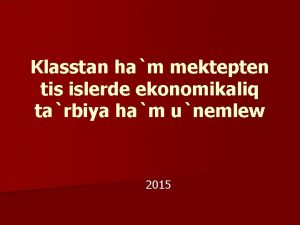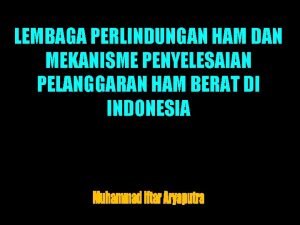Wi TT Cleantech Nicola Ham Edmonds ETI www


















- Slides: 18

Wi. TT: Cleantech Nicola Ham Edmonds, ETI www. eti. co. uk © 2012 Energy Technologies Institute LLP The information in this document is the property of Energy Technologies Institute LLP and may not be copied or communicated to a third party, or used for any purpose other than that for which it is supplied without the express written consent of Energy Technologies Institute LLP. This information is given in good faith based upon the latest information available to Energy Technologies Institute LLP, no warranty or representation is given concerning such information, which must not be taken as establishing any contractual or other commitment binding upon Energy Technologies Institute LLP or any of its subsidiary or associated companies.

What is Cleantech? n “Clean technology includes recycling, renewable energy (wind power, solar power, biomass, hydropower, biofuels), information technology, green transportation, electric motors, green chemistry, lighting, Greywater, and many other appliances that are now more energy efficient. ” n “Cleantech is a term used to describe products or services that improve operational performance, productivity, or efficiency while reducing costs, inputs, energy consumption, waste, or environmental pollution. Its origin is the increased consumer, regulatory, and industry interest in clean forms of energy generation—specifically, perhaps, the rise in awareness of global warming, climate change, and the impact on the natural environment from the burning of fossil fuels. The term cleantech is often associated with venture capital funds and land use organizations. ” n Wikipedia, 10 January 2011 2 © 2012 Energy Technologies Institute LLP Subject to notes on page 1

What is Cleantech? n “Clean technology includes recycling, renewable energy (wind power, solar power, biomass, hydropower, biofuels), information technology, green transportation, electric motors, green chemistry, lighting, Greywater, and many other appliances that are now more energy efficient. ” n “Cleantech is a term used to describe products or services that improve operational performance, productivity, or efficiency while reducing costs, inputs, energy consumption, waste, or environmental pollution. Its origin is the increased consumer, regulatory, and industry interest in clean forms of energy generation—specifically, perhaps, the rise in awareness of global warming, climate change, and the impact on the natural environment from the burning of fossil fuels. The term cleantech is often associated with venture capital funds and land use organizations. ” n Wikipedia, 10 January 2011 n Does it include nuclear, carbon capture and storage (CCS)? n Why is it important? n And what goes the Energy Technologies Institute (the ETI) do? 3 © 2012 Energy Technologies Institute LLP Subject to notes on page 1

Energy Technologies Institute Addressing the challenges of climate change and low carbon energy n n n Improving energy usage, efficiency, supply and generation Demonstrating systems and technologies Developing knowledge, skills and supply-chains Informing development of policy, regulation and standards Enabling deployment of affordable, secure, low carbon energy systems 4 © 2012 Energy Technologies Institute LLP Subject to notes on page 1 ETI Programme Associates ETI Project Partners Public Sector

Addressing the UK’s energy challenges Security Sustainability Affordability (£ 40/tonne) -80% fossil fuel baseline DUKES data 5 © 2012 Energy Technologies Institute LLP Subject to notes on page 1

Energy Consumption in Buildings 26 M buildings in the UK, 21 M remaining in 2050. UK housing consumes ~27% of the UK energy This accounts for ~26% of the UK CO 2 emissions 18% Other 22% Hot Water 60% Heating 6 © 2012 Energy Technologies Institute LLP Subject to notes on page 1 Energy use in domestic properties is the biggest single load on the UK energy system

Transport - Impacting 24% of UK CO 2 Addressing Key Energy Challenges in Heavy and Light Duty Vehicle Sectors Transport Aviation International Domestic Heavy Duty Marine 19% 2% 6% UK Transport CO 2 Emissions* *source: NAI 2006 HGV 15% Off-Road 7% Light Duty Rail 1% 2% Modal Shift (<10%) Increasingly Efficient Use of Liquid Fuels Transport CO 2 Emissions ≈ 24% of total UK emissions (excluding international components) © 2012 Energy Technologies Institute LLP – Subject to Notes on Page 1 Bus/Coach Commercial Vehicles 9% Passenger Cars 39% Alternative Energy Options

Addressing the UK’s 2020 and 2050 energy challenges requires. . . Setting a strategic direction Creating commercial confidence Viable commercial operation Full system demonstration § Reducing risk § Increasing § Bringing investor confidence together new supply- chains Which energy technologies do we need and when? 8 © 2012 Energy Technologies Institute LLP Subject to notes on page 1 Innovative technologies and sub-systems

The ETI’s UK Energy System Model PC based mathematical model identifying and evaluating options for design of the future UK Energy system n Generation and Demand n Power, Heat, Transport and Infrastructure Enables decision making on investment and prioritisation 9 © 2012 Energy Technologies Institute LLP Subject to notes on page 1 Unique design and operation Engineering system focus Spatial representation “What technologies might we need? ” “How might they integrate to meet UK demand? ” Includes UK geography – “Where might things need to be ? ” Probabilistic approach ‘Back-cast’ from 2050 to today “what is the likelihood that. . ? ” “What might we need when? ”

ETI 2011 portfolio - addressing key energy challenges Wind n Offshore specific system design and engineering Marine n Tidal Stream and Wave Distributed Energy (DE) n Combined Heat and Power (CHP), demand management, efficiency Buildings n Retrofit of new technologies and systems Energy Storage and Distribution n Infrastructure, heat and energy storage, fault management, smart networks Carbon Capture, handling and Storage (CCS) n Storage modelling, capture technologies, network design Transport n Electric vehicle infrastructure, heavy duty vehicle efficiency Bio Energy n Soil chemistry and agronomy, value chains, energy conversion Energy Systems Modelling (ESM) 10 © 2012 Energy Technologies Institute LLP Subject to notes on page 1 ETI technology strategy 2011

£ 133 m of major projects underway > £ 139 m of further projects in development CCS, DE, offshore wind, energy storage, smart systems, transport Bio Energy Buildings UK ESM (Energy System Model) Transport Organisations working on ETI projects – October 2011 CCS, 29 ESD Universities and Research Institutes SMEs DE Marine ETI Members Offshore Wind £ 133 m of projects announced 11 © 2012 Energy Technologies Institute LLP Subject to notes on page 1 Large Corporate Organisations

Major challenges for the UK energy system 2010 -2050 Supply-chain constraints Capacity, Build rates, Skills, International competition, . . . Biomass and Bio energy Land use, soil chemistry, value chain and supply chain sustainability, . . . © 2012 Energy Technologies Institute LLP Subject to notes on page 1 Electricity, Heat, CO 2, Transport. . . Requires ‘industrial scale’ deployment – for volume and rate Energy storage Intermittency, Heat, Security, Flexibility, Efficiency 12 Infrastructure development Buildings Retrofit, Efficiency, . . . Offshore renewables Wind, Marine

Challenges – Personal Observations Innovation, Innovation n Innovation is in Tech companies n SMEs - Skills, Capability and Resources n Collaboration: collaboration between SMEs, academics, corporates are essential. Cost : insufficient emphasis is on affordability: will consumer pay increasing cost Investment n Cost of the leap from lab scale to commercial scale n Uncertainty of commercial route to market (e. g. CCS, transport) Importance of consumer requirements (transport, smart systems) Climate change pendulum 13 © 2012 Energy Technologies Institute LLP Subject to notes on page 1

What is Cleantech? n “Cleantech is a term used to describe products or services that improve operational performance, productivity, or efficiency while reducing costs, inputs, energy consumption, waste, or environmental pollution. Its origin is the increased consumer, regulatory, and industry interest in clean forms of energy generation—specifically, perhaps, the rise in awareness of global warming, climate change, and the impact on the natural environment from the burning of fossil fuels. The term cleantech is often associated with venture capital funds and land use organizations. ” n Clean tech is every technology of the future 14 © 2012 Energy Technologies Institute LLP Subject to notes on page 1

Enabling…. Large-scale deployment through major industries Innovation pulled through from smaller enterprises and academia Sustained support for long-term incentives, skills development and regulatory frameworks 15 © 2012 Energy Technologies Institute LLP Subject to notes on page 1 © 2011 Energy Technologies Institute LLP Subject to notes on page 1

Building Partnerships Delivering Innovation Sharing risk Informing Policy Demonstrating Affordable systems for Secure, Low Carbon Energy 16 16 © 2011 Energy Technologies Institute LLP Subject to notes on page 1 © 2011 Energy Technologies Institute LLP Subject to notes on page 1 www. eti. co. uk

Current Project Partners Bio Energy Offshore Wind Marine Energy System Modelling Environment Distributed Energy Transport Carbon Capture & Storage Energy Storage & Distribution 17 © 2012 Energy Technologies Institute LLP Subject to notes on page 1 Buildings

The ETI Board Sir Rob Margetts Chairman David Clarke Chief Executive Industry Members David Eyton Group Vice President Technology BP Richard Case VP Marine and Petroleum Power Caterpillar Jörg Kruhl Head of New Technologies E. ON New Build and Technology Peter Hofman Director of Company Shared Services & Integration EDF Energy Chris Floyd Business Development Director Rolls-Royce plc John Mac. Arthur VP CO 2 Policy Shell International John Dodds Director of Innovation BIS David Delpy Chief Executive Officer EPSRC Iain Gray Chief Executive Officer Technology Strategy Board Public Sector representatives Observers Sir John Beddington Chief Scientific Adviser to UK Government Paul Hollinshead Director, Science and Innovation DECC Peter Bance Chief Executive P+M Intellectual Capital Sue Armfield ETI Secretariat BIS 18 © 2012 Energy Technologies Institute LLP Subject to notes on page 1
 Cleantech bulgaria
Cleantech bulgaria Tata cleantech capital limited
Tata cleantech capital limited Pamoja cleantech
Pamoja cleantech Ice trust
Ice trust Jeff edmonds yorku
Jeff edmonds yorku Citespace download
Citespace download Bruce edmonds
Bruce edmonds Sally guzman edmonds school district
Sally guzman edmonds school district Skyward edmonds
Skyward edmonds Chu liu edmonds algorithm
Chu liu edmonds algorithm Edmonds v lawson 2000
Edmonds v lawson 2000 Dr peck edmonds
Dr peck edmonds Mr edmonds meniscus song
Mr edmonds meniscus song Oblik sırt diş
Oblik sırt diş Eti winter tech week
Eti winter tech week Lösemide kan tablosu
Lösemide kan tablosu Sae 3061
Sae 3061 Otel banket menüleri
Otel banket menüleri Isef eti
Isef eti
